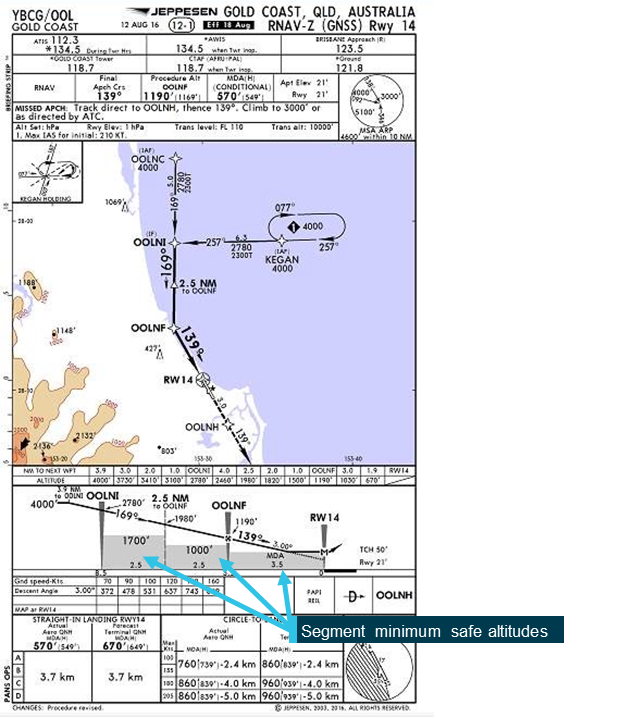Discontinuation notice
Published 8 January 2020
Section 21 (2) of the Transport Safety Investigation Act 2003 (TSI Act) empowers the Australian Transport Safety Bureau (ATSB) to discontinue an investigation into a transport safety matter at any time. Section 21 (3) of the TSI Act requires the ATSB to publish a statement setting out the reasons for discontinuing an investigation.
On 23 September 2016, the ATSB commenced an investigation into the descent below segment minimum safe altitude involving Airbus A330-343X, 9M-XXI, near Gold Coast Airport, Queensland, on 11 September 2016.
The aircraft was cleared to conduct a RNAV-Z (GNSS) instrument approach to runway 14 (Figure 1) at Gold Coast Airport in visual meteorological conditions. During the approach, the aircraft was observed to descend below the 1,700 ft segment minimum safe altitude between the instrument approach’s intermediate fix (OOLNI) and a position 2.5 NM from the final approach fix (OOLNF).
Figure 1: The Gold Coast RNAV-Z (GNSS) Rwy 14 non-precision instrument approach

Source: Jeppesen
The ATSB interviewed the flight crew and also examined the operator’s policies and procedures for the conduct of the RNAV-Z type approach. The flight crew reported that they had briefed the approach. That briefing included identification that the 2.5 NM position was not included in the aircraft’s navigation data base and that there was a segment minimum safe altitude requirement associated with this position.
The approach was flown using the autoflight system in a managed mode. As the aircraft approached the OOLNI, the aircraft was in a shallow descent and the flight crew commenced configuring the aircraft for landing (Figure 2). At OOLNI the aircraft was fully configured for landing and at a speed of 150 kt. As the aircraft passed through OOLNI, the autopilot pitched the aircraft down. The flight crew attempted to recover the speed through the application of speed brake. However this, coupled with the aircraft pitching down, resulted in an increased rate of descent, which in turn led to the penetration of the 1,700 ft segment minimum safe altitude. The aircraft subsequently returned to its targeted flight profile by OOLNF and continued the approach for landing.
Figure 2: The instrument approach vertical profile

Source: Jeppesen
The Flight Crew Training Manual (FCTM) for the A330 stated that the activation of the approach phase will initiate a deceleration towards the approach speed or a speed constraint inserted into the Final Descent Point (FDP). The FDP was defined as the capture point of the final descent segment coded into the navigation data base. The two approach techniques for the final descent segment were the decelerated approach and the early stabilised approach.
For the decelerated approach, the vertical flight profile was managed by the aircraft’s Flight Management Guidance and Envelope System (FMGES) using data in the aircraft’s navigation database, modified as required by the flight crew. This was described as using the autoflight system in a ‘managed mode’. The deceleration profile targeted having the aircraft at 1,000 ft above the landing point, in the landing configuration and at the approach speed. This profile generally equated to the aircraft being configured with the first stage of flap/slat and at the required speed at the FDP. In the discussion on the use of a managed vertical profile for a non-precision approach, the FCTM noted that for some non-precision approaches, ‘the final approach flies an “idle descent” segment from one altitude constraint to another, followed by a level segment’.
The early stabilised approach technique required the flight crew to have the aircraft in the landing configuration and at the approach speed at the FDP. The final descent segment was then flown using a selected vertical profile mode, such as the Flight Path Angle (FPA) mode.
The ATSB obtained the navigation database used by the FMGES for the RNAV-Z (GNSS) Rwy 14 approach. That database included initial (OOLNI) and final (OOLNF) approach fixes and their associated altitude limits, but did not include the point 2.5 NM from OOLNF and its associated segment minimum safe altitude limitation. The database also included a three degree approach profile from the OOLNF, but did not include a three degree profile before OOLNF.
The operator’s investigation into the occurrence identified that, as the three degree glide path started at OOLNF, the aircraft would conduct a stepped descent between OOLNI and OOLNF. The stepped approach profile was reflected by the autopilot pitching the aircraft down as it passed through OOLNI. In a stepped approach, on passing an altitude constrained position (such as OOLNI), the autopilot will fly an idle descent to the new altitude constraint and then fly level until the completion of that segment. The operator also noted that the step down limitation between OOLNI and OOLNF was not coded into the database due to specific coding rules. In response to the occurrence event, the operator custom coded the RNAV-Z (GNSS) Rwy 14 approach to include a 3 degree slope from OOLNI. The operator also issued a memorandum to all pilots requiring all non-precision approaches into Australia to be conducted using the selected vertical guidance Flight Path Angle mode only. Based on this information, the ATSB determined that it was unlikely that further ATSB investigation would identify any systemic safety issues. Consequently, the ATSB has discontinued this investigation.


